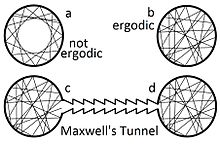Ergodic hypothesis


In
The ergodic hypothesis is often assumed in the
Assumption of the ergodic hypothesis allows proof that certain types of perpetual motion machines of the second kind are impossible.
Systems that are ergodic are said to have the property of ergodicity; a broad range of systems in geometry, physics, and probability are ergodic. Ergodic systems are studied in ergodic theory.
Phenomenology
In macroscopic systems, the timescales over which a system can truly explore the entirety of its own
However, complex disordered systems such as a spin glass show an even more complicated form of ergodicity breaking where the properties of the thermodynamic equilibrium state seen in practice are much more difficult to predict purely by symmetry arguments. Also conventional glasses (e.g. window glasses) violate ergodicity in a complicated manner. In practice this means that on sufficiently short time scales (e.g. those of parts of seconds, minutes, or a few hours) the systems may behave as solids, i.e. with a positive shear modulus, but on extremely long scales, e.g. over millennia or eons, as liquids, or with two or more time scales and plateaux in between.[2]
Ergodic hypothesis in finance
Models used in finance and investment assume ergodicity, explicitly or implicitly. The ergodic hypothesis is prevalent in modern portfolio theory, discounted cash flow (DCF) models, and aggregate indicator models that infuse macroeconomics, among others.
The situations modeled by these theories can be useful. But often they are only useful during much, but not all, of any particular time period under study. They can therefore miss some of the largest deviations from the standard model, such as
Nassim Nicholas Taleb has argued that a very important part of empirical reality in finance and investment is non-ergodic. An even statistical distribution of probabilities, where the system returns to every possible state an infinite number of times, is simply not the case we observe in situations where "absorbing states" are reached, a state where ruin is seen. The death of an individual, or total loss of everything, or the devolution or dismemberment of a nation state and the legal regime that accompanied it, are all absorbing states. Thus, in finance, path dependence matters. A path where an individual, firm or country hits a "stop"—an absorbing barrier, "anything that prevents people with skin in the game from emerging from it, and to which the system will invariably tend. Let us call these situations ruin, as the entity cannot emerge from the condition. The central problem is that if there is a possibility of ruin, cost benefit analyses are no longer possible."[3]—will be non-ergodic. All traditional models based on standard probabilistic statistics break down in these extreme situations.
Ergodic hypothesis in social science
In the social sciences, the ergodic hypothesis corresponds to the assumption that individuals are representative of groups, and vice-versa, that group averages can adequately characterize what might be seen in an individual. This appears to not be the case: group level data often gives a poor indication of individual level variation,[4][5] as individual standard deviations (SDs) tend to be almost eight times larger than group level SDs of the same people.[5] Subsequently a third of the individual observations falls outside a 99.9% confidence interval of group level data.
See also
- Ergodic process
- Ergodic theory, a branch of mathematics concerned with a more general formulation of ergodicity
- Ergodicity
- Loschmidt's paradox
- Poincaré recurrence theorem
- Lindy effect
References
- OCLC 01712811. ('Ergoden' on p.89 in the 1923 reprint.) It was used to prove equipartition of energy in the kinetic theory of gases.
- doi:10.1080/00018738200101438.. Also related to these time-scale phenomena are the properties of ageingand the Mode-Coupling theory of Götze, W. (2008). Dynamics of Glass Forming Liquids. Oxford Univ. Press.
- ^ Taleb, Nassim Nicholas (2019), "Probability, Risk, and Extremes", in Needham, Duncan (ed.), Extremes, Cambridge University Press, pp. 46–66
- S2CID 145323330.
- ^ PMID 29915059.
